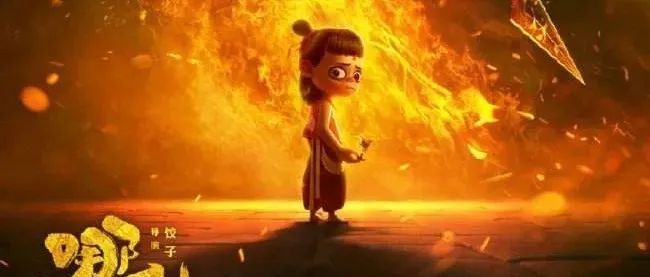Nezha: The Devil Child Descends to the World
Zhang Sanjian is back 2022-05-05 03:00 posted on Beijing
I’ve wanted to write a review for this film for a long time, but unfortunately, I haven’t found a suitable starting point. In my opinion, this Chinese animated film is too perfect, perfect to be a good experience from any perspective. After repeatedly watching it, I found a suitable term to serve as the starting point for the entire film – contrast.
As you watch the entire movie, you will find that except for Nezha’s parents, who fit every parent’s traditional image, all other characters have significant contrasts with traditional images, breaking our consistent impressions. So, let me start from the contrasting perspective and try to explain why this movie has been so successful and deeply touching.

The first two main characters appear on screen- Taiyi Zhenren and Shengong Bao. A fairy who talks like Trump, is he down to earth or not? An antagonist who stutters, isn’t he funny? Taiyi Zhenren breaks our image of celestial beings being noble and imposing – celestial beings are no longer handsome, upright, shining with righteousness; instead, they are chubby, boastful, love to drink, and do things recklessly, leading to the tragic turn of events.

What about Shengong Bao? A ruthless, powerful antagonist, yet he is a god who struggles to articulate a single sentence. It’s precisely because of his stutter that he brings many humorous moments and creates crucial misunderstandings that allow the story to unfold naturally.
In many films and TV shows, good and bad characters are often stereotyped. Good characters must be handsome or beautiful, with well-proportioned facial features, dignified and righteous. Bad characters, on the other hand, must look like wanted criminals. If the creation follows such a format, it loses a lot of color in the character’s personality and dramatic conflict. People often wear “masks” to disguise themselves in daily life; would a bad person have “bad” written on their face? Such scriptwriting only confines directors and actors.
So, this review aims to tell everyone that a sense of contrast is precious.
Having discussed the superficial appearance, let’s delve into the deep personalities of these two supporting roles. Taiyi Zhenren and Shengong Bao, in terms of magical power, Shengong Bao has a clear advantage, and in terms of diligence, he surpasses Taiyi Zhenren by far. But why did Yuan Shi Tianzun leave the last seat of the Twelve Golden Immortals for Taiyi Zhenren? This is because of his understanding of the essence through appearances.
Taiyi Zhenren is brave, kind, willing to take responsibility, and harbors great love. He sacrifices centuries of cultivation to save Nezha and Ao Bing. On the other hand, Shengong Bao is narrow-minded, believing that prejudices in people’s hearts are like an insurmountable mountain. If you can’t let go of your own biases, how can you expect others to do so? When the heavenly calamity arrives, he escapes without hesitation. This makes me think of the workplace – if you were a boss, would you choose a loyal employee, who admits mistakes, and is amiable, or someone intelligent, cunning, always ready to switch jobs or even backstab? The answer is self-evident; understanding a person’s internal qualities is more important, so don’t be blinded by appearances.
Next, let’s talk about the contrast between the two main characters, which is a source of infinite imagination – the contrast between ice and fire, red and blue, impulsiveness and calmness. From the story itself, the plot unfolds by swapping the identities of the demon pearl and the spirit pearl.
Mrs. Yin, a kind-hearted woman who should have given birth to the reincarnation of the spirit pearl Nezha after a three-year pregnancy, has her spirit pearl stolen by Shengong Bao due to his senior brother’s alcoholism, turning Nezha into the reincarnation of the demon pearl. The spirit pearl is reincarnated as the dragon prince – Ao Bing.
Here, the East Sea Dragon Palace also has a significant contrast with traditional images. Our impression of the Dragon Palace is magnificent, with shrimp soldiers and crab generals standing tall and mighty – of course, this is derived from memories of Journey to the West. In theory, Ao Bing, the proper dragon prince, should be majestic, but he carries the burden of the dragon clan’s millennium-long anticipation, akin to being shackled. The Dragon Palace is just a cage suppressing sea monsters, and each dragon is tied with heavy iron chains. On the other side, Nezha is born into a wealthy family but cannot step out of the mansion, and people’s prejudices against him are predetermined from the moment of his birth.
Nezha’s image is not the traditional one with a spirited and divine appearance, a red dot in the middle of his forehead. Instead, he has a flat nose, heavy dark circles, a messy room, hands in his pockets, and loves to recite poetry – the image of a naughty boy. On the other hand, Ao Bing makes his entrance as a handsome young noble.
The demon pearl and the spirit pearl were originally a mixed Yuan pearl, both good and evil, yin and yang. Yuan Shi Tianzun forcibly separated them and cast a heavenly curse on the demon pearl. So, Nezha and Ao Bing are originally of the same root, but Nezha has only three years of life. They share a common point – they both belong to a different category. Excellence or evilness different from ordinary people is treated as something different.
These two children, treated as different from an early age, grew up separately. When they meet, they realize there are things in the world that resonate with each other in such a frequency. One is human, the other is a demon, yet they become each other’s only friends – one shoulder the dragon clan’s millennium mission, the other has only three years of life; one is gentle and knowledgeable, repaying kindness when owed, the other is mischievous and unruly; one is the spirit pearl but has to bury the entire Qiantang Pass, the other is the demon pearl but shouts, “My destiny is mine, not dictated by heaven,” saving all the people. Ao Bing goes against the current and transforms into a dragon, while Nezha overcomes inner demons and breaks free. Just when Nezha’s strength is about to be depleted, Ao Bing uses the Dragon Scale Armor to buy him time, and they overcome themselves, saving each other. Appearance and essence freely battle in the film, making people exhilarated while contemplating. Does the innate “evil” guide the innate “justice” to find the right path, contrasting sharply with the traditional story of Nezha pulling tendons and skinning the dragon prince?
In this film, two characters left a profound impression on me, one being the white-haired old man who appears at the beginning and end of the film. The old man in this movie is not a wise person but one who, under the guise of petitioning for the people and eliminating harm, tries to persuade Li Jing and his wife to morally justify killing their child. What’s interesting is that the director designed him as a blind man, pretending to stand on the people’s standpoint based on what he “hears,” and morally speaking a righteous speech to a wooden statue. Then there’s the “strong man” who keeps screaming like a girl; I think people’s fear and prejudice against Nezha are to a large extent led by that scream – “Nezha is here!” Is Nezha really so scary and frightening? Is he truly unforgivable? It’s just the atmosphere created by some people’s quirky behavior.
Mrs. Yin tightly embraces her newborn Nezha, letting her child bite and endure injuries, playing shuttlecock with her son, even though she is battered and bruised – this moved me deeply. Li Jing’s attempt to sacrifice himself for his child with a life-swapping talisman at the end made me shed tears in the cinema. Maternal love is like water, and paternal love is like a mountain, both perfectly presented in the film. I checked the traditional story of Nezha and the Dragon Prince in Fengshen Yanyi and found that the biggest contrast is actually the parents, Li Jing and his wife.
In the traditional story, Li Jing initially wants to kill Nezha, later forces Nezha to commit suicide, and destroys his ancestral hall. Nezha returns home to seek revenge against his father – it’s a typical manifestation of the “Oedipus kills his father” plot. Nezha’s traditional mother is also weak and submissive, yielding to her husband in everything, without the heroic protection of her son.
Readers can explore the descriptions of the traditional story on their own; scenes like tendon-pulling and skinning are heart-wrenching, and I don’t want to go over them one by one. Here, I just want to thank the director for shaping a pair of “perfect” parents, and passing down the belief that “a parent’s heart is compassionate to all.” Filial piety is the greatest virtue, and Chinese people should never forget their parents’ kindness. This “Nezha: The Devil Child Descends to the World” establishes a banner for modern Chinese animated films, setting a benchmark and showing the world Chinese stories, proving that Chinese animation is not inferior to any foreign animated films. With a cultural heritage of five thousand years, there are many Chinese stories worth exploring and promoting. I believe such an outstanding film will inspire all filmmakers.
Go, Chinese cinema!









I’m Nezha’s fan now 🤣🤣
翻译 Translate
Waiting for Nezha 2 review ❤️
翻译 Translate
Make I cry even more till this morning.
翻译 Translate
This Nezha and Zhangzhehan fate have many similar points.
翻译 Translate
It’s really good movie.
翻译 Translate
I’m back reading your review again .
翻译 Translate
As a result I can’t write a letter.
翻译 Translate
I cried a lot.
翻译 Translate
I watched Nezha 1 last night.
翻译 Translate
I’m check in ❤️
翻译 Translate
Hi~~ Mr.Believer , we often meet 🥰
翻译 Translate
Hi~~~
翻译 Translate
I never watch it yet. I will. I will.
翻译 Translate
San Jian would likely admire characters like Nezha or Wukong, who pursue their true selves without being confined by limitations. These figures embody a spirit of freedom and self-discovery that resonates with his worldview.
翻译 Translate